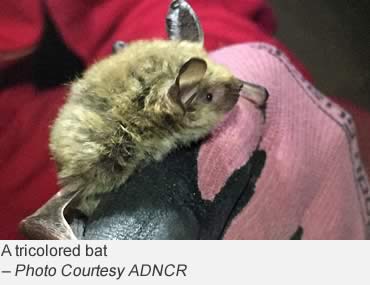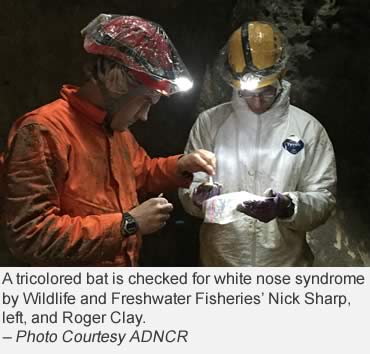Photo: Gray bats exit one of thousands of caves in Alabama to forage for insects during the night. – Photo Courtesy Steve Davis/ADNCR
One of the most maligned species in the animal kingdom is under scrutiny in Alabama, for good reason. Nick Sharp, Wildlife and Freshwater Fisheries Division’s nongame biologist, puts the situation in perspective.
“If you care about food then you should care about bats,” Sharp said. “All the bats we have in Alabama are insectivores. Gray bats can eat 3,000 insects in a night. Sauta Cave at Scottsboro is one of the most famous bat caves in the U.S. If you go to Sauta Cave in the summer, you’ll see 250,000 to 300,000 bats emerge at dusk. If you multiply that number by 3,000 insects per individual, those bats are eating a billion insects a night.
“It’s enough to provide an agricultural service in the form of reduced needs for pesticides and reducing crop damage.”
A recently published research study indicated that the bat population plays a significant role in mitigating corn crop damage from insects to the tune of more than $1 billion per year worldwide.
“Before the article on corn came out, there was research that estimated bats were worth $3.7 billion in services to agriculture in North America,” Sharp said. “If you think about it, our entire economy almost is based on corn. If you go to the store to buy a steak, all of our livestock are fed on corn. Just about everything you eat has corn in it in some way. And we’re even pumping corn ethanol into our cars. I don’t think people understand how pervasive corn is in our economy.”
The danger of White Nose Syndrome
That is one of the reasons conservation professionals are so concerned about white-nosed syndrome, a fungus that attacks certain bat species and can cause significant mortality.
“When you think that white-nose syndrome has killed more than six million bats in North America, if it continues to kill bats to that degree as it advances toward the West Coast, you’re talking about a significant impact on our economy,” Sharp said. “If you like to eat, you should be a proponent of bats. It’s just that simple.”
 It’s obvious why Sharp and fellow biologists are gathering as much information as possible about the bat population in Alabama and the impact of white-nose syndrome. Sharp recently checked caves for bat population numbers.
It’s obvious why Sharp and fellow biologists are gathering as much information as possible about the bat population in Alabama and the impact of white-nose syndrome. Sharp recently checked caves for bat population numbers.
“We have three threatened and endangered bats in the state: the gray bat, the Indiana bat and the northern long-eared bat,” Sharp said. “A fourth species, the tricolored bat, has been heavily affected throughout its range and is of conservation concern.
“We’re doing what we can to get a handle on how widespread white-nose syndrome is in the state and what effect it’s having on the bats, both in numbers and species present.”
When bats hibernate, biologists investigate
Sharp and his colleagues will soon be conducting sampling on bats hibernating during the winter to see if white-nose syndrome is present, and it doesn’t always manifest in the white fuzzy fungus seen on the muzzles and forearms of some bats.
“We’re trying to detect the fungus, we’re counting bats as best we can to try to determine if there is a change in populations over time,” Sharp said.
Before Sharp joined the team, retired biologist Keith Hudson formed the Alabama Bat Working Group to study bat populations and white-nose syndrome.
“Recent research revealed that affected bats don’t always display visible symptoms,” Sharp said.
“Sometimes it’s at the terminal stages of the disease before they exhibit symptoms. So we’ve begun using cotton swabs moistened with a DNA preservative to rub along the muzzle and forearms. We send it to a lab to look for the DNA of the fungus that causes the disease.”
Last year, Sharp teamed with the U.S. Geological Service’s National Wildlife Health Center to expand the sampling beyond the known affected range in north Alabama. The news was good after the completion of the survey.
 “We went into Bibb, Covington, Conecuh and Monroe counties to see if any bat populations there were affected,” he said. “We did not detect it any further south than we knew it to be in the state. We’ll do that again this year with the hope that it doesn’t get down south.”
“We went into Bibb, Covington, Conecuh and Monroe counties to see if any bat populations there were affected,” he said. “We did not detect it any further south than we knew it to be in the state. We’ll do that again this year with the hope that it doesn’t get down south.”
Sharp said there are more than 6,000 caves in Alabama and many, many are used by bats. The survey encompasses those caves known to house greater numbers of bats, particularly the myotis genus that includes gray bats, Indiana bats and northern long-eared bats that hibernate in large groups and clusters.
Tricolored bats will likely be found in those same areas, but they tend to roost individually all throughout the caves.
“Tricolored bats are the most common and the most numerous,” Sharp said. “One of the problems is that, before white-nose syndrome, it was such a common bat that nobody paid attention and nobody was counting that bat closely. But we do have a handful of caves for which we have count data for that bat. So we’re focusing on continuing those counts in those caves.
Sharp said Georgia saw a significant decline in the number of tricolored bats last year, but that has not been detected in Alabama, yet.
So far, so good
“We have counted numbers in caves that were low, but not lower than any historical counts,” he said. “It was not outside the normal variance. In the caves, we haven’t seen any large numbers of dead bats.”
While tricolored bats may have higher numbers nationwide, Sharp said Alabama is the heart of gray bat country.
“We have the largest and most important summer roost for gray bats in the world in Sauta Cave in Jackson County,” he said. “And we have the largest and most important hibernaculum (hibernation site) for gray bats in Fern Cave, also in Jackson County. So Alabama is very important for gray bat populations.
“And it appears the gray bat is resilient to white-nose syndrome. We don’t know why, but we haven’t seen any indication gray bat numbers are declining. Gray bats congregate in summertime in large numbers. Keith had been going to gray bat caves and attempting to count them in the evening. We’re continuing to do that, but it’s difficult when you’ve got 100,000 bats flying around.”
Sharp said Fern Cave is one of a dozen known major hibernacula for gray bats. The problem is the cave is difficult to access.
Maybe a million bats in one cave
“You have to be an advanced caver to get into Fern Cave because it’s a big hole in the ground,” he said.
“It’s so immense it poses great challenges to try to do a count. So that’s a known unknown about how many gray bats are in Fern Cave. There are probably a million, but nobody knows for sure.”
Sharp went to Fern Cave recently to look for spots where he could erect nets to catch several for gray bat sampling.
“We have some gray bats that have been banded,” he said. “We know people have seen lots of bats with bands in Fern in the wintertime. With the nets, we will try to recover some of the bats for that banding information.”
Sharp said a secondary objective in the research is to try to determine the range and numbers of Indiana bats and northern long-eared bats in Alabama.
“Those bats hibernate in caves, but they roost in trees in summertime,” he said. “They have maternity colonies in trees. They roost under the bark of shagbark hickories or dead pine trees. We know we have a few Indiana bat maternity roosts in Talladega National Forest. We don’t know of any maternity roosts for the northern long-eared bat.”
Undeserved reputation
Sharp surmises that one of the reasons for the bat’s spooky reputation is it can be a rabies vector.
“But that has been blown out of proportion,” he said. “The chance of getting rabies from a bat is exceptionally low.”
Sharp said it’s especially rewarding when he is able to handle a captured bat.
“It’s amazing when you hold it in your hand,” he said. “Those bats are looking at you. They’re not blind. You can see the bats looking at you and following you. These are intelligent, social animals. They live in family groups in large numbers. They have social communications.
“If you can get over your initial bias of what we’ve all be taught, they are really fascinating animals.”
— By David Rainer / Alabama Department of Conservation and Natural Resources